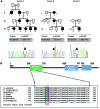SLFN14 mutations underlie thrombocytopenia with excessive bleeding and platelet secretion defects
- PMID: 26280575
- PMCID: PMC4588283
- DOI: 10.1172/JCI80347
SLFN14 mutations underlie thrombocytopenia with excessive bleeding and platelet secretion defects
Abstract
Inherited thrombocytopenias are a group of disorders that are characterized by a low platelet count and are sometimes associated with excessive bleeding that ranges from mild to severe. We evaluated 36 unrelated patients and 17 family members displaying thrombocytopenia that were recruited to the UK Genotyping and Phenotyping of Platelets (GAPP) study. All patients had a history of excessive bleeding of unknown etiology. We performed platelet phenotyping and whole-exome sequencing (WES) on all patients and identified mutations in schlafen 14 (SLFN14) in 12 patients from 3 unrelated families. Patients harboring SLFN14 mutations displayed an analogous phenotype that consisted of moderate thrombocytopenia, enlarged platelets, decreased ATP secretion, and a dominant inheritance pattern. Three heterozygous missense mutations were identified in affected family members and predicted to encode substitutions (K218E, K219N, and V220D) within an ATPase-AAA-4, GTP/ATP-binding region of SLFN14. Endogenous SLFN14 expression was reduced in platelets from all patients, and mutant SLFN14 expression was markedly decreased compared with that of WT SLFN14 when overexpressed in transfected cells. Electron microscopy revealed a reduced number of dense granules in affected patients platelets, correlating with a decreased ATP secretion observed in lumiaggregometry studies. These results identify SLFN14 mutations as cause for an inherited thrombocytopenia with excessive bleeding, outlining a fundamental role for SLFN14 in platelet formation and function.
Figures



References
-
- Noris P, et al. Application of a diagnostic algorithm for inherited thrombocytopenias to 46 consecutive patients. Haematologica. 2004;89(10):1219–1225. - PubMed
-
- Watson SP, Lowe GC, Lordkipanidze M, Morgan NV. Genotyping and phenotyping of platelet function disorders. J Thromb Haemost. 2013;11(suppl 1):351–363. - PubMed
Publication types
MeSH terms
Substances
Grants and funding
LinkOut - more resources
Full Text Sources
Medical
Molecular Biology Databases

